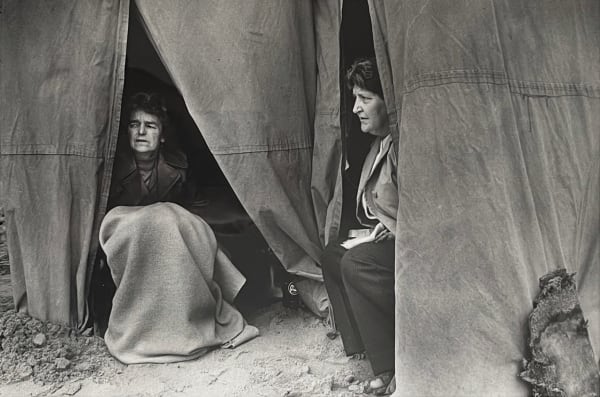Czech-born Markéta Luskačová has lived in the UK since 1975 and first went to North East England in 1976 when visiting photographer Chris Killip, who at that time lived there. She fell in love with Whitley Bay, and with the people there who, in spite of the harsh weather, enjoyed their time at the seaside. When Amber, a film and photography collective, invited her in 1978 to photograph the North East of England alongside Martine Franck, Henri Cartier-Bresson and Paul Caponigro, she was drawn back to photograph the seaside.
In 1978 Markéta Luskačová held one of her first exhibitions with some of her earliest pictures taken in England. The exhibition was staged at the Side Gallery in Newcastle, presented seaside pictures taken in the North East of England and was entitled Photographs from the Beaches. Sirkka-Liisa Konttinen & Markéta Luskačová . The Hyman Collection includes vintage prints from this series.
In 2019 six photographs from this series were selected for inclusion in the touring exhibition Seaside: Photographed. This major group exhibition examined the relationship between photographers, photography and the British seaside from the 1850s to the present. Luskačová returned to her photographs from the mid 1970s to select a group of works that included previously exhibited photographs as well as unexhibited works which she printed for the first time for inclusion in the exhibition. This edit of six signed silver gelatin prints was acquired by The Hyman Collection.
Also in 2019 the Martin Parr Foundation presented new digital prints of a selection of these works and RRB photobooks published Markéta Luskačová - By The Sea: Photographs from the North East 1976-1980.
Luskačová explains:
“I was very touched by it all: the families with children, old women in their best hats, elderly couples with grandchildren, teenagers courting shyly or boisterously, the ponies and donkeys walking patiently to and fro on the beach. The dogs and children were everywhere, dogs enjoying themselves as much as the children did. The fairground and the omnipresent tents, fortresses against the wind and rain, the seaside cafes selling sandwiches, apple pies, custard pies, ice creams and teas, of course. But they also sold boiling water to women who brought with them from their homes their teapots and teabags, because to buy tea for the whole family would be too expensive.”

 Markéta Luskačová, N E Seaside (Skinningrove), 1976View more details
Markéta Luskačová, N E Seaside (Skinningrove), 1976View more details Markéta Luskačová, N E Seaside, 1978View more details
Markéta Luskačová, N E Seaside, 1978View more details Markéta Luskačová, N E Seaside (Whitley Bay), 1978View more details
Markéta Luskačová, N E Seaside (Whitley Bay), 1978View more details Markéta Luskačová, Seaside, 1978View more details
Markéta Luskačová, Seaside, 1978View more details Markéta Luskačová, Seaside, 1978View more details
Markéta Luskačová, Seaside, 1978View more details Markéta Luskačová, Seaside, 1978View more details
Markéta Luskačová, Seaside, 1978View more details Markéta Luskačová, Seaside, 1978View more details
Markéta Luskačová, Seaside, 1978View more details Markéta Luskačová, Seaside, 1978View more details
Markéta Luskačová, Seaside, 1978View more details Markéta Luskačová, Seaside, 1978View more details
Markéta Luskačová, Seaside, 1978View more details








